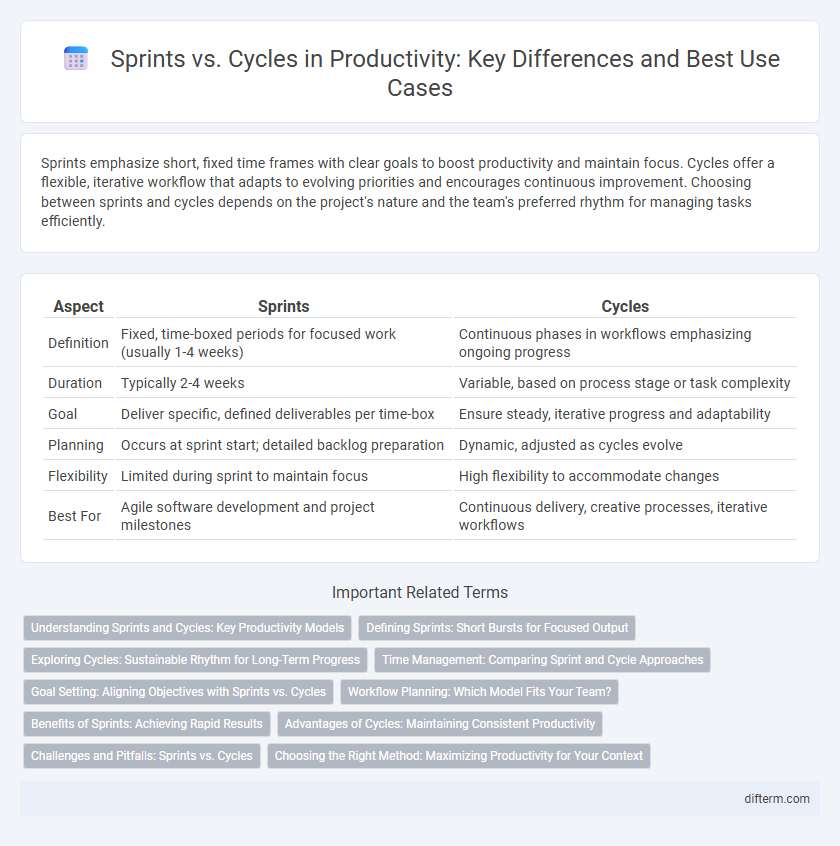Sprints emphasize short, fixed time frames with clear goals to boost productivity and maintain focus. Cycles offer a flexible, iterative workflow that adapts to evolving priorities and encourages continuous improvement. Choosing between sprints and cycles depends on the project's nature and the team's preferred rhythm for managing tasks efficiently.
Table of Comparison
| Aspect | Sprints | Cycles |
|---|---|---|
| Definition | Fixed, time-boxed periods for focused work (usually 1-4 weeks) | Continuous phases in workflows emphasizing ongoing progress |
| Duration | Typically 2-4 weeks | Variable, based on process stage or task complexity |
| Goal | Deliver specific, defined deliverables per time-box | Ensure steady, iterative progress and adaptability |
| Planning | Occurs at sprint start; detailed backlog preparation | Dynamic, adjusted as cycles evolve |
| Flexibility | Limited during sprint to maintain focus | High flexibility to accommodate changes |
| Best For | Agile software development and project milestones | Continuous delivery, creative processes, iterative workflows |
Understanding Sprints and Cycles: Key Productivity Models
Sprints and cycles are essential productivity models used to structure work into manageable timeframes, enhancing focus and efficiency. Sprints typically refer to fixed, short bursts of intense productivity, often lasting 1 to 4 weeks, as popularized in Agile project management. Cycles encompass broader periods that may include multiple sprints or phases, allowing for iterative progress and continuous improvement in workflows.
Defining Sprints: Short Bursts for Focused Output
Sprints are short, time-boxed periods typically lasting one to four weeks, designed to maximize focused output on specific tasks or goals. Their structured duration helps teams maintain high productivity and clear priorities, minimizing distractions and scope creep. By concentrating efforts within these bursts, sprints enhance accountability and facilitate rapid progress evaluation in agile productivity frameworks.
Exploring Cycles: Sustainable Rhythm for Long-Term Progress
Exploring cycles as a sustainable rhythm promotes steady productivity by balancing focused work periods with intentional rest, preventing burnout and maintaining high performance. Unlike sprints, cycles emphasize consistent, manageable workloads that align with natural energy fluctuations, supporting long-term progress. Implementing cycles fosters resilience and adaptability, essential for continuous improvement and sustained success in complex projects.
Time Management: Comparing Sprint and Cycle Approaches
Sprint methodologies emphasize focused, short bursts of work, typically lasting 1-4 weeks, maximizing productivity through intensive time-boxed efforts. Cycle approaches adopt longer, recurring intervals, allowing for iterative evaluation and adjustment, promoting sustainable pacing and continuous improvement. Time management effectiveness depends on project demands, with sprints driving urgency and cycles enabling strategic flexibility.
Goal Setting: Aligning Objectives with Sprints vs. Cycles
Sprints prioritize short-term goal setting by breaking down objectives into focused, time-boxed tasks that enhance team alignment and immediate delivery. Cycles encompass longer periods, allowing for broader goal-setting that integrates iterative feedback and strategic adjustments. Aligning objectives with sprints ensures rapid progress, while cycles support comprehensive planning and continuous improvement.
Workflow Planning: Which Model Fits Your Team?
Sprints in Agile methodology offer time-boxed, focused work periods ideal for teams seeking rapid iteration and clear deadlines, promoting accountability and measurable progress. Workflow cycles provide a more flexible, continuous process suited for teams managing ongoing tasks and adapting priorities without strict time constraints. Choosing between sprints and cycles depends on your team's project complexity, need for adaptability, and preference for structured versus fluid workflow planning.
Benefits of Sprints: Achieving Rapid Results
Sprints enable teams to focus intensely on short-term goals, driving rapid progress and quick delivery of functional product increments. This approach fosters continuous feedback, allowing for swift adjustments and improvement within condensed timeframes. The accelerated pace of sprints enhances productivity by maintaining momentum and minimizing prolonged phases of uncertainty.
Advantages of Cycles: Maintaining Consistent Productivity
Cycles promote consistent productivity by providing a steady rhythm that helps teams avoid burnout commonly associated with intense sprints. This approach enables continuous progress through manageable work intervals, enhancing focus and reducing fatigue. Maintaining a balanced workload in cycles supports sustainable output and long-term efficiency.
Challenges and Pitfalls: Sprints vs. Cycles
Sprints often face challenges like burnout and rushed deliverables due to their intense, fixed timeframes, while cycles may struggle with maintaining momentum and clear deadlines, leading to project delays. Teams using sprints must guard against scope creep and ensure effective sprint planning, whereas cycle-based workflows require robust monitoring to prevent procrastination and loss of focus. Balancing flexibility and discipline is crucial in both methodologies to optimize productivity and meet project goals consistently.
Choosing the Right Method: Maximizing Productivity for Your Context
Choosing between sprints and cycles depends on project complexity and team dynamics, with sprints offering focused, time-boxed goals ideal for rapid development and frequent feedback. Cycles provide a more flexible timeframe suited for ongoing, iterative improvement and long-term projects where adaptability is key. Aligning the method with your team's workflow and project requirements maximizes productivity by optimizing task management and stakeholder communication.
Sprints vs Cycles Infographic

 difterm.com
difterm.com